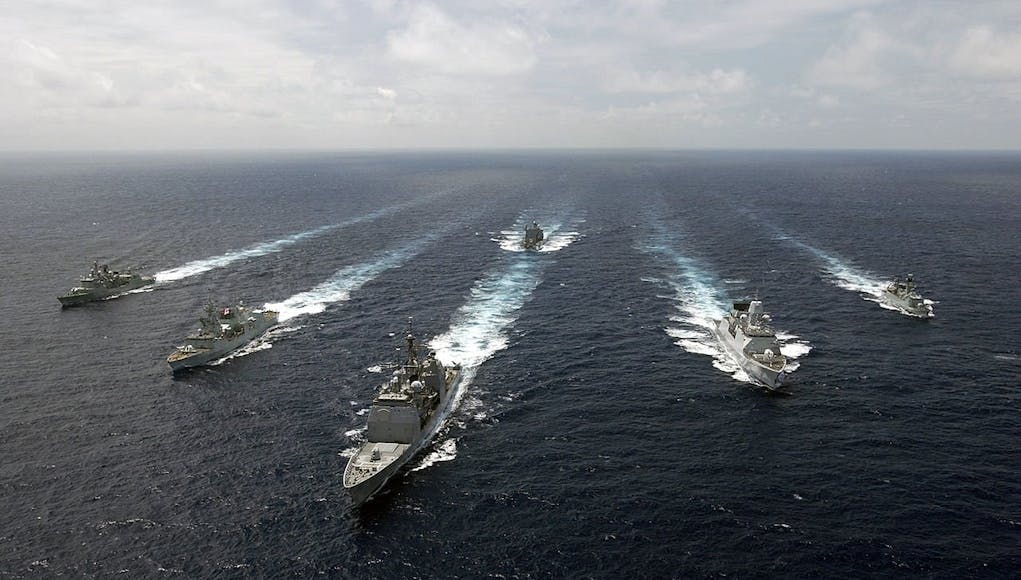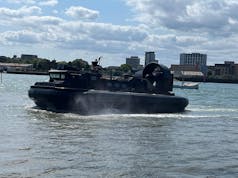Standing NATO Maritime Group One departed Rostock, Germany after completing a scheduled port visit last week.
While in Rostock, say NATO, sailors were able to take a break from operations and enjoy some time off the ship, visiting local areas, taking tours and hosting a reception aboard SNMG1 ship, Polish frigate ORP General Kazimierz Pulaski.
In port, SNMG1 hosted a reception which included distinguished visitors and local military from the area in the hangar aboard ORP General Kazimierz Pulaski.
“One of the missions of SNMG1 is to strengthen the relationships we have among our NATO allies and partners,” said Lt. Lyndsi Gutierrez, SNMG1 public affairs officer.
“One of the many ways we accomplish that mission is through regularly scheduled port calls and engagements with our host nations, like this visit to Rostock.”
During the reception Rear Adm. Edward Cashman, Commander of SNMG 1, spoke to the guests about the reason of NATO’s visit to Rostock.
“Rostock has a long history of being a maritime city. Even today the sea plays an important role in trade and prosperity. The sea is not a barrier that divides people and places; it’s a freeway, a great global common that connects them. The security of that global common is a primary mission of NATO, the Allied Maritime Command, and of SNMG1.”
SNMG1 is currently composed of the U.S. flagship guided-missile destroyer USS Gravely, the German navy replenishment tanker FGS Spessart, and the Polish guided-missile frigate ORP General K. Pulaski and is one of four standing maritime task groups composed of ships from various Allied countries.
These task groups form the core maritime capability of NATO’s Very High Readiness Joint Task Force (VJTF). They provide a continuous maritime capability to execute NATO missions across the spectrum of operations.














So, they are in the Baltic. Timely?
Do we get rid of our ships too soon? The ORP General K. Pulaski is a former Oliver Hazard Perry commissioned in the late 1970s. Seeing ships like that and many former RN vessels still operated by other navies does make you wonder if we could simply increase our escort fleet by not getting rid of older ships so readily.
Some of the T23s could be retained for home waters, leaving the T45s and T26s for CBG duty, plus the T31s and R2s for constabulary roles further afield.
Exactly we should retain and keep more ships both to use and to keep for the nation as museum ships ect the type 23s could be used in easier climates than our waters the North Sea and Atlantic is pretty rough at times maybe forward base 5 type 23s in over seas territory’s like the French they have 5 frigates doing that! then still buy the type 26 and 31s, I can’t see it happening though unfortunately.
personally id like to see one type 23 become a museum ship in Portsmouth with 4 or 5 pot in to the reserve fleet. while it would be nice to see them still in active use. the issue is it just increases the different amount of hulls in the water and therefore an additional expense to the RN supply structure.
Of manning is the issue and bringing a reserve ship back into service costs a bundle. However, donating a T23 to a new ‘Baltic’ navy would help.
I was more thinking of keeping them in active service but with lower usage i.e. keep 5 hulls with 3 crews and rotate. Keep them in and around UK waters for training and shadowing our Ruskie friends. 3 would then be available in times of conflict with a couple more able to be brought into service should they be needed.
I doubt very much that the T31s will be ‘fighty’ enough to be of much use in conflict, too much FFBNW I would imagine. Keeping some T23s active would keep some ‘lethality’ (to coin a GW phrase) within the fleet and would certainly be cheaper than buying more T26s.
The RN should/could hugely increase the naval/marine reserves. Ten we could certainly keep some 23’s. But we could also have more flexibility over commissioning. For different missions we could have different ships available with the crews to man them.
At the very least older ships should be put into a reserve flotilla.
I think we do get rid of them too soon, yes.
Part of the reason is that we build so use that the ones in our fleet get a lot of miles on the clock very quickly. This is what will happen to Type 45s; as there are only 6 they will be used so much that they will have half the longevity that we envisaged during initial design.
The sheer long-term cost of maintenance over their combined lives will probably exceed that of a 7th or 8th ship.
The same will likely happen with F35 and Astutes.
It’s all well and good keeping ships in reserve, but it raises numerous questions.
Firstly, you’ll have yet another hull type, with all the associated costs involved. It’s not that that in itself is a *major* problem, but aging hulls and a lack of commonality between newer vessels serve to increase costs. As the T23 maintenance and parts production programme draws to a close, and the number of vessels in service shrinks, these vessels will become even more costly to maintain, thus affecting their availability.
Secondly, even in a ‘reserve’ situation, they still act as money pits. You’ll have to pour a significant sum of money into them each year, with regular drydocking, maintenance and inspections. Without this, they’ll require even more money spent on them to bring them back to life. Iron Duke, recently sent to Devonport for refit, is in a bad way due to this. She will need significant work to repair the effects of weathering whilst she was laid up. But even then, most ships will need to enter a significant refit phase before deploying. Crews will need to be trained on a dated, unfamiliar platform. Complex weapon and IT systems will need to be stored for reactivation at a later date. All of this costs money – and time – for a platform which may never be used again. Decommissioned ships will also be utilised as a Christmas Tree for the RN, with all useful parts stripped to keep the remaining numbers going.
There’s also the fact that many of the systems on the Type 23 will be used on the Type 26 and Type 31e, so any ship in a reserve fleet is likely to be… weaponless. We don’t exactly have a massive collection of dated weapon systems stored, so the most we could muster would likely be a few cannons and maybe an odd missile system or two at best. All this would take time to integrate with the modern fleet, and again add more financial costs to the programme.
There have only been a few instances where reserves have been necessary. Obviously, the Falklands War is one example, which saw three Tribal Class vessels brought back into service for a couple of years. Secondly, the announcement of the reactivation of HMS Severn can be seen as an example of this, but she was still a young vessel, maintained in low readiness, and costs far less to run annually. This was money well spent, her early decommissioning was a silly idea.
Honestly, the Type 23s have had their day, and they have done our nation a great service – each vessel will have put in over 30 years graft when they decommission. Maintaining a reserve fleet is simply a money pit, and we’d be far better investing that money into extra T31e hulls OR using it to upgrade the weapon systems of the Batch 1 vessels.
That said, I wouldn’t be against keeping one as a museum, though I do feel that role should fall to HMS Bristol.
What is folly, however, was the decision to sell off three Type 23s early, and decommission several Type 22’s well before their time. That’s partly why we’re in such a mess with a diminished escort fleet. But maintaining a small number of Type 23’s won’t solve this.
Good post Lusty.
On the face of it I too would be all in favour of keeping ships in reserve but when the realities are pointed out, then no.
I guess the US military have such a huge budget they can do things like that.
I believe the Russians keep old kit just in case too though.
Agree,with the benefit of hindsight it would have made more sense to sell the Type 22’s ( 3 B2’s were scrapped/sunk ) and keep the 3 Type 23’s.
The article is a bit late.
They have all just spent the weekend in Devonport. The busiest I have seen the sea wal for a long while and the best time for a Dockyard and Warships tour if that’s your thing.
OHP class looks very dated but was spotless.